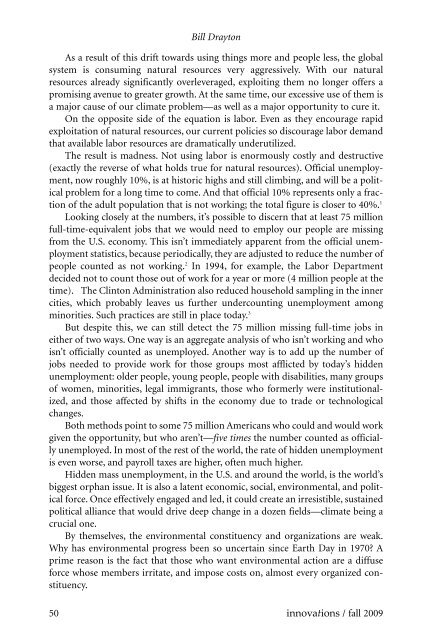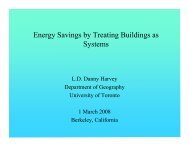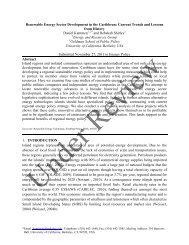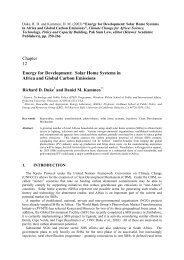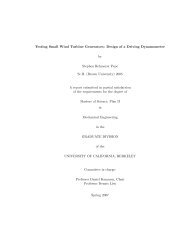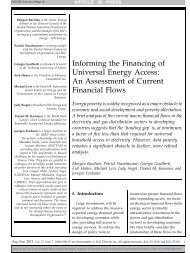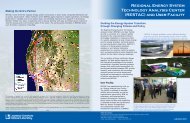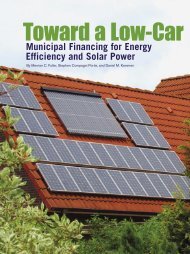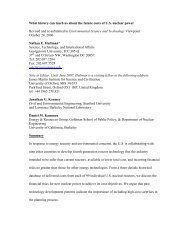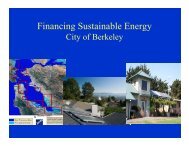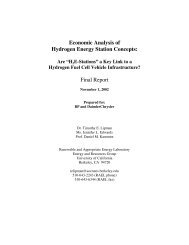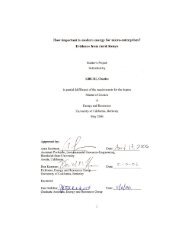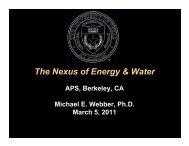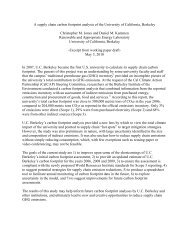Innovations, Energy for Change, Fall 2009.pdf - Renewable and ...
Innovations, Energy for Change, Fall 2009.pdf - Renewable and ...
Innovations, Energy for Change, Fall 2009.pdf - Renewable and ...
Create successful ePaper yourself
Turn your PDF publications into a flip-book with our unique Google optimized e-Paper software.
Bill Drayton<br />
As a result of this drift towards using things more <strong>and</strong> people less, the global<br />
system is consuming natural resources very aggressively. With our natural<br />
resources already significantly overleveraged, exploiting them no longer offers a<br />
promising avenue to greater growth. At the same time, our excessive use of them is<br />
a major cause of our climate problem—as well as a major opportunity to cure it.<br />
On the opposite side of the equation is labor. Even as they encourage rapid<br />
exploitation of natural resources, our current policies so discourage labor dem<strong>and</strong><br />
that available labor resources are dramatically underutilized.<br />
The result is madness. Not using labor is enormously costly <strong>and</strong> destructive<br />
(exactly the reverse of what holds true <strong>for</strong> natural resources). Official unemployment,<br />
now roughly 10%, is at historic highs <strong>and</strong> still climbing, <strong>and</strong> will be a political<br />
problem <strong>for</strong> a long time to come. And that official 10% represents only a fraction<br />
of the adult population that is not working; the total figure is closer to 40%. 1<br />
Looking closely at the numbers, it’s possible to discern that at least 75 million<br />
full-time-equivalent jobs that we would need to employ our people are missing<br />
from the U.S. economy. This isn’t immediately apparent from the official unemployment<br />
statistics, because periodically, they are adjusted to reduce the number of<br />
people counted as not working. 2 In 1994, <strong>for</strong> example, the Labor Department<br />
decided not to count those out of work <strong>for</strong> a year or more (4 million people at the<br />
time). The Clinton Administration also reduced household sampling in the inner<br />
cities, which probably leaves us further undercounting unemployment among<br />
minorities. Such practices are still in place today. 3<br />
But despite this, we can still detect the 75 million missing full-time jobs in<br />
either of two ways. One way is an aggregate analysis of who isn’t working <strong>and</strong> who<br />
isn’t officially counted as unemployed. Another way is to add up the number of<br />
jobs needed to provide work <strong>for</strong> those groups most afflicted by today’s hidden<br />
unemployment: older people, young people, people with disabilities, many groups<br />
of women, minorities, legal immigrants, those who <strong>for</strong>merly were institutionalized,<br />
<strong>and</strong> those affected by shifts in the economy due to trade or technological<br />
changes.<br />
Both methods point to some 75 million Americans who could <strong>and</strong> would work<br />
given the opportunity, but who aren’t—five times the number counted as officially<br />
unemployed. In most of the rest of the world, the rate of hidden unemployment<br />
is even worse, <strong>and</strong> payroll taxes are higher, often much higher.<br />
Hidden mass unemployment, in the U.S. <strong>and</strong> around the world, is the world’s<br />
biggest orphan issue. It is also a latent economic, social, environmental, <strong>and</strong> political<br />
<strong>for</strong>ce. Once effectively engaged <strong>and</strong> led, it could create an irresistible, sustained<br />
political alliance that would drive deep change in a dozen fields—climate being a<br />
crucial one.<br />
By themselves, the environmental constituency <strong>and</strong> organizations are weak.<br />
Why has environmental progress been so uncertain since Earth Day in 1970? A<br />
prime reason is the fact that those who want environmental action are a diffuse<br />
<strong>for</strong>ce whose members irritate, <strong>and</strong> impose costs on, almost every organized constituency.<br />
50 innovations / fall 2009


